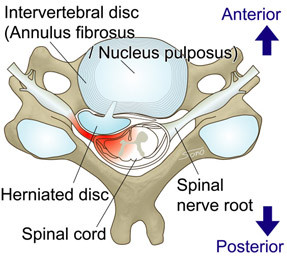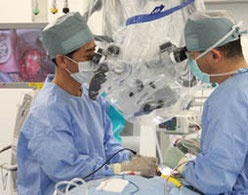Cervical Disc Herniation
Symptom
Myelopathy is caused by direct compression of spinal cord in cervical spine. In this pathological condition, patients develop motor weakness of upper and lower extremities, painful numbness of upper extremity as well as gait difficulty.
Radiculopathy is caused by direct compression of
the cervical nerve root. Those who suffer from arm pain or numbness may be common as cervical radiculopathy.



Surgical Treatment
There are options for surgical treatments. Here we present Anterior Cervical Discectomy and Fusion (ACDF).
Operative Microscope
Precise and delicate operation is required to ensure that spinal nerve is protected throughout each surgery. Using operative microscope is necessary to achieve this. Operative microscope is also advantageous to preserve as much muscle tissues as possible during Minimally Invasive Surgery (MIS).
Procedure
First, a small incision is made around neck skin. From there, we reach to cervical vertebrae by following tissue boundaries. This
way, we can avoid possible damages to muscles if done otherwise. Intervertebral disc is removed to pull out herniated disc. After spinal nerve is decompressed, screw-like metallic implants called
cages are inserted to the disc space to fuse upper and lower vertebrae. This procedure enables patients to leave their beds early after operation.
Outcome
In many cases, symptoms should clearly improve if herniated disc is removed in early development.